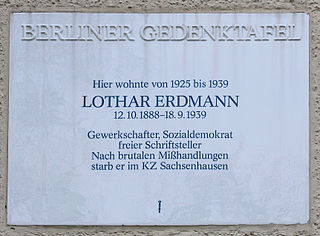Related Research Articles

Vereinte Dienstleistungsgewerkschaft is a German trade union based in Berlin, Germany. It was established on 19 March 2001 as the result of a merger of five individual unions and is a member of the German Trade Union Confederation (DGB). With around 1.9 million members, Verdi is the second largest German trade union after IG Metall. It currently employs around 3000 members of staff in Germany and has an annual income of approximately 454 million Euros obtained from membership subscriptions. The trade union is divided into 10 federal state districts and five divisions and is managed by a National Executive Board (Bundesvorstand) with nine members. Frank Bsirske was the chairman of Verdi from its founding in 2001 until September 2019, when Frank Werneke was elected.

The Swiss Trade Union Federation is the largest national trade union center in Switzerland.

The Free Association of German Trade Unions was a trade union federation in Imperial and early Weimar Germany. It was founded in 1897 in Halle under the name Representatives' Centralization of Germany as the national umbrella organization of the localist current of the German labor movement. The localists rejected the centralization in the labor movement following the sunset of the Anti-Socialist Laws in 1890 and preferred grassroots democratic structures. The lack of a strike code soon led to conflict within the organization. Various ways of providing financial support for strikes were tested before a system of voluntary solidarity was agreed upon in 1903, the same year that the name Free Association of German Trade Unions was adopted.
The National Socialist German Students' Union was founded in 1926 as a division of the Nazi Party with the mission of integrating University-level education and academic life within the framework of the Nazi worldview. Organized strictly in accord with the Führerprinzip as well as the principle of Machtdistanz, the NSDStB housed its members in so-called Kameradschaftshäusern, and had its members decked out in classic brown shirts and its own distinctive Swastika emblems.
Karl Roche (1862–1931) was a German syndicalist and left communist trade unionist. Roche joined the Free Association of German Trade Unions (FVdG) around 1900 as a seaman. He became a prominent member of the organization.
The General German Trade Union Federation was a confederation of German trade unions in Germany founded during the Weimar Republic. It was founded in 1919 and was initially powerful enough to organize a general strike in 1920 against a right-wing coup d'état. After the 1929 Wall Street crash, the ensuing global financial crisis caused widespread unemployment. The ADGB suffered a dramatic loss of membership, both from unemployment and political squabbles. By the time the Nazis seized control of the government, the ADGB's leadership had distanced itself from the Social Democratic Party of Germany (SPD) and was openly cooperating with Nazis in an attempt to keep the organization alive. Nonetheless, on May 2, 1933, the SA and SS stormed the offices of the ADGB and its member trade unions, seized their assets and arrested their leaders, crushing the organization.
The General Commission of German Trade Unions was an umbrella body for German trade unions during the German Empire, from the end of the Anti-Socialist Laws in 1890 up to 1919. In 1919, a successor organisation was named the Allgemeiner Deutscher Gewerkschaftsbund, and then in 1949, the current Deutscher Gewerkschaftsbund was formed.

The German Metal Workers' Union was a German industrial union for metalworkers formed in 1891 and dissolved after the Nazis' accession to power in 1933.

Karl Hermann Dietrich Lothar Erdmann was a German journalist. During the Weimar Republic he was the editor of the trade union theory organ Die Arbeit. He was a main supporter of the turning away of trade unions from social democracy at the end of the Republic. Despite his rapprochement with National Socialism, he died after maltreatment in the Sachsenhausen concentration camp.

The Union of Miners of Germany was a trade union representing miners in Germany.
Reichsvereinigung der Deutschen Gewerkschaften was a trade union centre in the First Czechoslovak Republic. The organization had its headquarters on Krakovská street 11 in Prague. Initially the Reichsvereinigung grouped all the main German nationalist, or völkisch, trade unions in the Sudetenland. As of 1921, the affiliates of the Reichsvereinigung claimed to have 49,500 members. By the end of 1928, the organization claimed to have 51,500 members. The Reichsvereinigung was a supposedly apolitical body for German workers.
Deutschsozialistische Bergarbeiterverband was a Nazi trade union for German miners in Czechoslovakia. It was founded in 1922. The union was based in Most. As of 1929, it claimed to have 3,371 members. The union was linked to the German National Socialist Workers Party (DNSAP). Heinrich Proste was the leader of the union. Deutschsozialistische Bergarbeiterverband was affiliated with the Reichsvereinigung der Deutschen Gewerkschaften. The union published the monthly Der deutscher Bergmann from Most between 1924 and 1933.
Bund deutscher Gewerkschaften was a German völkisch trade union centre in Czechoslovakia. The organization was founded in 1934. Politically it was linked to the German National Party. It had its headquarters in Tetschen. Its main union was the Deutsche Arbeitnehmergewerkschaft, Tetschen. D.A.N.T. had 6,278 members as of around 1934.
Union der Bergarbeiter in der CSR, initially known as Union der Bergarbeiter Österreichs, was a miners trade union of miners in Austria and the First Czechoslovak Republic 1903–1938. Initially a multi-ethnic union in Habsburg Austria (Cisleithania), it was divided along ethnic lines in 1910. After the establishment of the Czechoslovak Republic, it became a union for miners of German ethnicity.
Národní sdružení odborových organizací was a trade union centre in the Czechoslovakia. Politically it was linked to the right-wing Czechoslovak National Democratic Party. The centre was organized by the former socialist Josef Hudec. As of 1929 organization was divided in 7 sections and had 304 branches.
The German Leather Workers' Union was a trade union representing workers involved in tanning and glovemaking.
The Central Union of Bakers and Confectioners was a trade union representing workers in bakeries and related trades in Germany.
The Union of Domestic Workers of Germany was a trade union representing domestic staff in Germany.
The Union of Porcelain and Related Workers of Germany was a trade union representing workers in the ceramic industry in Germany.
Paul Hensel was a German trade unionist.
References
- ↑ Mitteilungen des Statistischen Staatsamtes der Čechoslovakischen Republik. Herausgegeben vom Statistischen Staatsamte. 1930. p. 1296.
- 1 2 3 Deutsche Arbeitsfront. Arbeitswissenschaftliches Institut (1938). Das Sudetendeutschtum, seine wirtschaftlichen, sozialen und geschichtlichen Grundlagen. Verlag der Deutschen Arbeitsfront GmbH. p. 35.
- 1 2 3 Ročenka Československé republiky. 1931. p. 323.
- ↑ Jaroslav Šebek (2010). Sudetendeutscher Katholizismus auf dem Kreuzweg: politische Aktivitäten der sudetendeutschen Katholiken in der Ersten Tschechoslowakischen Republik in den 30er Jahren. LIT Verlag Münster. pp. 38–39. ISBN 978-3-8258-9433-7.